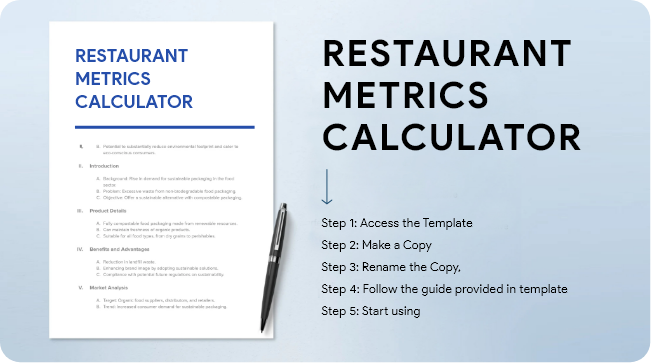Download Free Restaurant Metrics Calculator
Welcome to our Restaurant Metrics Calculator —a powerful tool designed to simplify and enhance your restaurant’s event management process. In this guide, we’ll explore the benefits of using a Restaurant Metrics Calculator for your restaurant and provide step-by-step instructions on how to effectively utilize this invaluable resource.

What Can You Find?
An Excel spreadsheet calculator, thoughtfully organized with dedicated tabs, each brimming with formulas and calculations meticulously crafted to empower you in assessing essential metrics for your restaurant. This Excel tool is tailored to empower your decision-making and financial management, offering a holistic view of your restaurant’s performance at your fingertips.
In the restaurant industry, several key financial and operational metrics are crucial for effective management and success:

Break-Even Point: The break-even point is the level of sales at which a restaurant covers all its costs and neither makes a profit nor incurs a loss. It’s a critical metric for understanding when your restaurant becomes financially self-sufficient.

Overhead Rate: The overhead rate represents the percentage of a restaurant’s total expenses that are not directly tied to the production of food, such as rent, utilities, insurance, and administrative costs. Calculating this rate helps in understanding and managing fixed expenses.

Employee Turnover Rate: Employee turnover rate measures the frequency at which employees leave and are replaced within a restaurant. A high turnover rate can indicate issues with staffing, training, or work environment, which can impact operational efficiency and customer satisfaction.

Cost of Goods Sold (COGS): COGS is the cost incurred by a restaurant to purchase or produce the food and beverages it sells. It’s a vital metric for assessing the cost-effectiveness of your menu and pricing strategies.

Labor & Prime Cost: Labor and prime cost represent the total cost of labor (wages, benefits) and COGS combined. It’s an essential metric for understanding the core expenses involved in running a restaurant and managing profitability.

Gross Profit: Gross profit is the revenue generated from sales minus the COGS. It reflects the profit earned before deducting other operating expenses. Monitoring gross profit helps gauge the financial health and profitability of a restaurant.
Optimize your time and effort with automated tip calculations. Eliminate the need for cross-referencing reports from various systems or weekly manual tip data extraction. Simply integrate your custom tip rules with Milagro POS data for automatic tip distribution.
